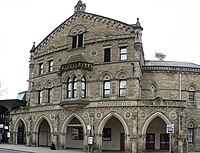Theatre Royal, York

Front Facade of York's Theatre Royal, March 2006
|
|
| Address | St. Leonard’s Place |
|---|---|
| Location | York, England |
| Coordinates | 53°57′43″N 1°05′07″W / 53.96196°N 1.08530°WCoordinates: 53°57′43″N 1°05′07″W / 53.96196°N 1.08530°W |
| Type | Theatre |
| Capacity | 847 |
| Opened | 1744 |
| Website | |
| www |
|
York Theatre Royal is a theatre in St. Leonard's Place, York, England, which dates back to 1744. The theatre currently seats 847 people. This reduced capacity (from 863) takes into account removal of the mixing position seats and the stage side boxes which are normally not sold. Whilst the theatre is traditionally a proscenium theatre, it was reconfigured for a season in 2011 to offer productions in-the-round. The theatre puts on many of its own productions, under its Artistic Director Damian Cruden, as well as hosting touring companies, one of which is Pilot Theatre, a national touring company which co-produces its work with the theatre. Additionally the main stage and studio are regularly used by local amateur dramatic and operatic societies. York Theatre Royal was one of the co-producers of the historic York Mystery Plays 2012 which were staged in York Museum Gardens between 2–27 August.
York Theatre Royal was built in 1744 on, and among, the site of the medieval St. Leonard's Hospital. Parts of the old hospital can still be seen in the modern building, including archways and walls. Under the stage lies a well, which is believed to be dated from the Roman era of York's history. The 1744 theatre replaced a theatre in Minster Yard, built by Thomas Keregan, with the encouragement of the City Corporation, in 1734. Twenty five years after its construction, in 1769, Tate Wilkinson paid £500 for a Royal Patent, and, accordingly, it was renamed the Theatre Royal. Wilkinson ran a company that included theatres in Hull, Leeds, Pontefract, Wakefield and other Yorkshire towns. His company was reckoned to be the leading provincial company, and he attracted many of the finest actors of the period, including John Philip Kemble and his sister Sarah Siddons, Dorothea Jordan and Elizabeth Farren, to act in York. Since Wilkinson's time the theatre has undergone several renovations and upgrades. In the late 1800s the theatre was refurbished into the Victorian style, including, in 1880, a new Victorian Gothic frontage, which is decorated with carved heads representing Elizabeth I and characters from Shakespeare's plays. The latest major redevelopment was an extensive renovation of the theatre, with a new modernist foyer (architect: Patrick Gwynne), in 1967. The theatre has been designated a Grade II* listed building by English Heritage.
...
Wikipedia
